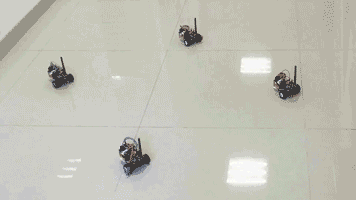Self-coordinated Vehicle Formation
Robots use UWB technology for self-coordinating positioning.
Background
This project was developed from October 2015 to March 2017, advised by Prof. Yuan Shen.
In September 2015, inspired by a TED Talk and this paper, I became interested in swarm robotics.
The drone demo was pretty cool. However, it required OptiTrack for localization. In contrast, the self-assembly robot swarm did not require a base station for locating each node, though this limited the movement abilities of the inner nodes.
After reading this paper, I came up with an idea for a self-coordinated robot system. If each robot node could know the distance between any 2 nodes, all nodes would have enough information to calculate the group's formation. This scheme eliminates the need for a base station.




After nodes A, B, C and D perform ranging using broadcast messages, all nodes receive sufficient information.
To implement this idea, we chose ultra-wideband (UWB) wireless technology. Using Decawave DWM1000 transceiver modules, we were able to measure distances between two modules with millimeter precision. However, as no existing API was available in late 2015, we had to develop the measurement algorithms and communication protocols ourselves.


From October 2015 to May 2016, I developed the first version of this project, handling the entire workload—including the circuit, mechanism, embedded system, ranging algorithm, and broadcast protocol—all by myself, except for the motor driver which was designed by Zhe Weng.
From June 2016 to July 2016, Feng Ge assisted with the Decawave protocols for the second version. Additionally, I redesigned the motor driver to a brand new version:)
Subsequently, Laixi Shi, Wenhao Ding, Tuopu Wen, and Junda Bi joined and contributed to the final version.
Brief Introduction to the Project
We use ultra-wideband (UWB) wireless technology to measure the distance between any two robot cars, eliminating the need for a base station to localize any car. The cars self-coordinate to determine their positions.

Demostrations of This Project
We broadcast the goal to every node, allowing them to determine their movements autonomously without remote control from central nodes or humans.
Formation Change
The video below demostrates how the robot system transforms from a line into a rectangle shape.
The images below show the robot system changing in size.


Maintain Formation
The images below show the robot system maintaining its rectangular formation while rotating.


The images below show the robot system maintaining its rectangular formation while moving.



